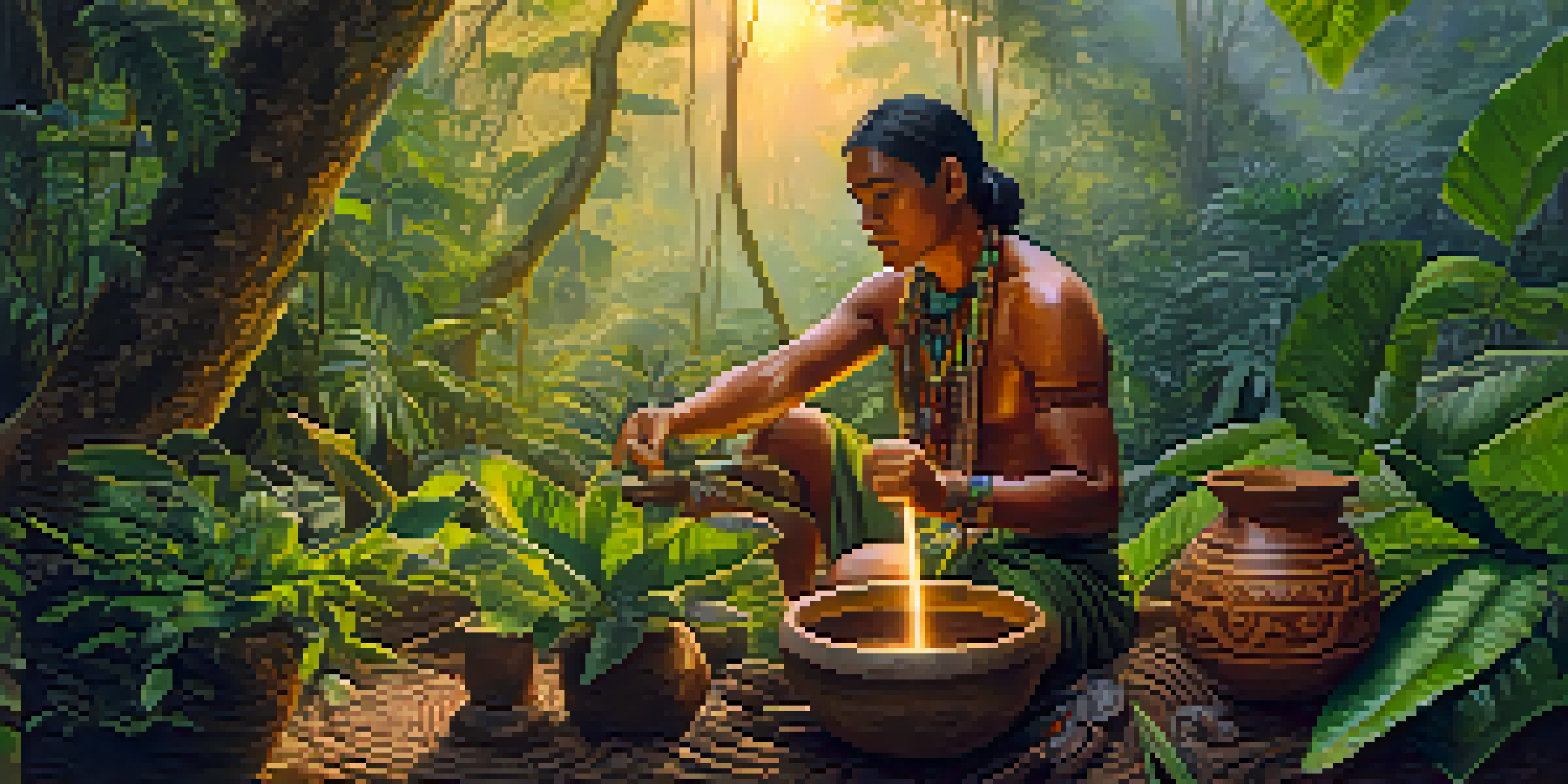The Ecological Footprint of Ayahuasca: A Critical Analysis

Understanding Ayahuasca and Its Origins
Ayahuasca is a traditional Amazonian brew made from the Banisteriopsis caapi vine and other plants. It has been used for centuries by indigenous tribes for spiritual healing and rituals. The brew’s popularity has surged globally, attracting those seeking transformative experiences and insights.
In every walk with nature one receives far more than he seeks.
The cultural significance of Ayahuasca is profound, often intertwined with the identity and traditions of indigenous communities. However, as interest grows, so does the demand for the ingredients that constitute this sacred drink. This shift raises important questions about sustainability and the ecological implications of harvesting these plants.
Understanding the origins and traditional uses of Ayahuasca is crucial for appreciating its cultural context. Yet, as the world becomes more interconnected, the need for a critical analysis of its ecological footprint becomes increasingly urgent.
The Demand for Ayahuasca: A Growing Trend
In recent years, Ayahuasca retreats have become a booming industry, attracting tourists from around the world. This surge in demand has led to an increase in the cultivation of the plants used in the brew. While this growth can benefit local economies, it also raises concerns about overharvesting and ecological degradation.

As more people seek out these transformative experiences, the pressure on indigenous communities to supply Ayahuasca grows. This situation can lead to unsustainable practices that threaten the delicate ecosystems where these plants thrive. It's essential to recognize the balance between cultural preservation and the environmental impact of this trend.
Ayahuasca's Cultural Significance
Ayahuasca is deeply rooted in indigenous traditions, serving as a vital tool for spiritual healing and cultural identity.
The popularity of Ayahuasca highlights a broader conversation about consumption and its effects on the planet. By understanding the demand and its implications, we can start to address the ecological challenges associated with Ayahuasca production.
Ecological Consequences of Ayahuasca Harvesting
Harvesting the components of Ayahuasca often involves cutting down vines and collecting leaves from various plants, which can disrupt local ecosystems. This practice can lead to habitat loss for numerous species that rely on these plants for survival. The consequences of such ecological disruption can ripple through the environment, affecting biodiversity.
The earth does not belong to us: we belong to the earth.
Furthermore, the increased cultivation of these plants can lead to monoculture farming, where a single crop is grown extensively. This practice can deplete soil nutrients and increase vulnerability to pests, ultimately compromising the health of the land. Sustainable practices are crucial to mitigate these negative impacts.
It’s vital to recognize that the ecological footprint of Ayahuasca goes beyond the immediate effects of harvesting. The environmental implications extend to the health of the ecosystems and communities that depend on the biodiversity of the Amazon rainforest.
Indigenous Perspectives on Sustainable Practices
Indigenous communities have long maintained a symbiotic relationship with the plants of the Amazon. Their traditional practices emphasize sustainability and respect for nature, which can offer valuable insights into modern conservation efforts. Understanding these perspectives is key to developing sustainable approaches to Ayahuasca production.
Many indigenous groups advocate for the preservation of their cultural heritage alongside the environment. They often employ methods that promote biodiversity and soil health, resisting the pressures of industrial farming. Collaborating with these communities can lead to more sustainable practices that honor both tradition and ecological health.
Ecological Impact of Demand
The growing global demand for Ayahuasca raises concerns about overharvesting and the ecological consequences for the Amazon rainforest.
By listening to indigenous voices, we can learn how to balance the demand for Ayahuasca with the need for ecological preservation. Their knowledge can guide us toward practices that respect the land while meeting the needs of a global audience.
The Role of Ethical Tourism in Ayahuasca Retreats
Ethical tourism has emerged as a vital component in the conversation surrounding Ayahuasca retreats. Tourists are increasingly seeking retreats that prioritize sustainability and respect for indigenous cultures. By choosing ethical options, travelers can help ensure that their presence does not harm the very ecosystems they wish to explore.
A focus on ethical tourism can also lead to positive economic impacts for local communities. When retreats operate sustainably, they can provide fair compensation for indigenous guides and contribute to conservation efforts. This model fosters a mutually beneficial relationship between tourists and the communities they visit.
Ultimately, ethical tourism can play a significant role in reducing the ecological footprint of Ayahuasca consumption. By making informed choices, travelers can support practices that protect the environment while enjoying their spiritual journeys.
Innovative Solutions for Sustainable Ayahuasca Practices
As awareness of the ecological footprint of Ayahuasca grows, innovative solutions are emerging to address these challenges. Sustainable farming practices, such as agroforestry, can help restore and maintain biodiversity while providing a steady supply of the necessary plants. These methods promote ecological balance and can be more resilient to climate change.
Additionally, initiatives that involve reforestation and habitat restoration are critical for rehabilitating damaged ecosystems. By investing in these projects, we can create a future where Ayahuasca can be harvested sustainably without compromising the health of the Amazon rainforest.
Importance of Ethical Tourism
Ethical tourism can promote sustainability and support local communities, ensuring that Ayahuasca practices do not harm the environment.
Collaboration among indigenous communities, environmental organizations, and the tourism industry is essential for implementing these solutions. Together, they can create a holistic approach to Ayahuasca production that respects cultural traditions while protecting the environment.
Conclusion: Balancing Tradition and Sustainability
The ecological footprint of Ayahuasca highlights a complex interplay between tradition and modern demand. As interest in this ancient brew continues to rise, it’s crucial to balance cultural practices with environmental stewardship. The future of Ayahuasca lies in sustainable practices that honor both the earth and the communities that have preserved its wisdom.
By prioritizing ethical tourism, supporting indigenous voices, and implementing innovative farming techniques, we can mitigate the ecological impacts associated with Ayahuasca. It’s a collective responsibility to ensure that the allure of Ayahuasca does not come at the expense of the ecosystems that nurture it.

In conclusion, understanding and addressing the ecological footprint of Ayahuasca is essential for its continued existence. By fostering a culture of sustainability, we can enjoy the benefits of this profound experience while protecting the rich biodiversity of the Amazon.